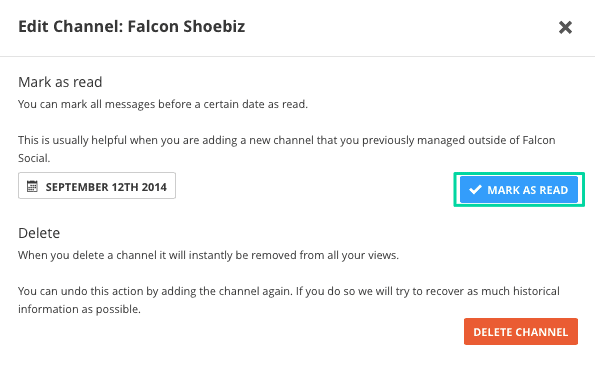In this article:
- How do I follow a X (Twitter) user in Engage?
- How do I clear all my unread messages in Engage?
- If you label a comment as spam, does it get marked as spam on the native network as well?
- Why can comment counts differ between Engage and Measure?
- Do I get an alert when notes are added to a comment?
- How do you calculate the number of new messages?
- Why are no LinkedIn customers included in my Engage exports?
- What do the different message colors indicate?
- Will replying to content natively be marked as read in Engage?
How do I follow a X (Twitter) user in Engage?
When you click on a conversation with a X (Twitter) user in Engage, you will see their profile card in the top left of the conversation. Click on the Follow button on their profile card to follow them with the X (Twitter) channel indicated on the button tooltip.
How do I clear all my unread messages in Engage?
From within your organization’s settings, select channels and click on the relevant channel. From the popup window, choose the date range to mark as read to and select Mark as read. The system will then mark any unread messages as read up until the date you choose.

If you label a comment as spam, does it get marked as spam on the native network as well?
A comment will only be marked as spam within Social Media Management and not on the native network. After marking a comment as spam in Social Media Management, you can choose to delete the comment and still maintain a record of its original content.
Why can comment counts differ between Engage and Measure?
A difference in comment counts between Engage and Measure can be expected and several factors often contribute:
- Usage of different APIs: When Engage shows a comment count, it is based on the number of comments we have indexed from the native network based on their data restrictions when sharing to third-party applications like Brandwatch. When Measure shows a comment count, it is usually based on data fetched via the network APIs, such as the Facebook Insights API. Since the source of the data is different, this can result in a difference in comment count between our tools.
- Deleted content: If a comment is deleted on the native network, there may be a delay in our platform detecting it, or deletion detection for that particular comment type may not yet be implemented or supported. These instances can contribute to more comments being indexed than currently available on the native network. If Measure shows a lower comment count, keep in mind that Measure fetches a current total from the dedicated network API.
- Permission issues: We may not have the permissions to index every existing comment from the native network. Some comments are hidden by their authors, or the token we possess is not permitted to fetch certain comment types. We only receive a very specific view of the natively available content. Engage reflects this view, while Measure usually reports numbers as provided by Facebook or the native network, and those numbers don’t reflect our specific constraints on visibility.
- Differences between the native network and SMM: What we consider a single post might be considered several pieces of content by the native network and vice versa. This is typically true for promoted content. On the Insights API, Facebook might consider comments under different versions of the same ad to be additive and then Measure will reflect that, or they might report all comments under all posts. Engage, however, will report the actual number of indexed comments for any post.
As the platform works currently, comment counts between different products are expected and are best viewed as separate metrics. What Measure reports can be described as what a network is telling us, while in Engage comment counts can be seen as how much information Social Media Management can collect from the native data.
Do I get an alert when notes are added to a comment?
There is currently no option to get a notification when notes have been added to a comment. However, the Notes button will be highlighted in blue to make users aware of the fact that there are notes attached to this thread.
How does Engage calculate the number of new messages?
The number of messages in the left-hand menu reflects the number of conversations that contain unread comments or messages. So if one conversation thread has 100 unread comments, Engage will show that you have one new conversation to review.
Why are no LinkedIn customers included in my Engage exports?
To remain compliant with LinkedIn's terms of service, it's not possible to include LinkedIn customers, customer data, or conversations in Audience and Engage exports.
What do the different message colors indicate?
Each message type in Engage has its own color. A message or comment from a user is white, a written reply is blue, an automated reply is green, and an internal note is yellow.
Will replying to content natively be marked as read in Engage?
No, content responded to natively will not be marked as read in Engage. If you reply to a piece of content in your native account, you will need to mark it as read in Engage.